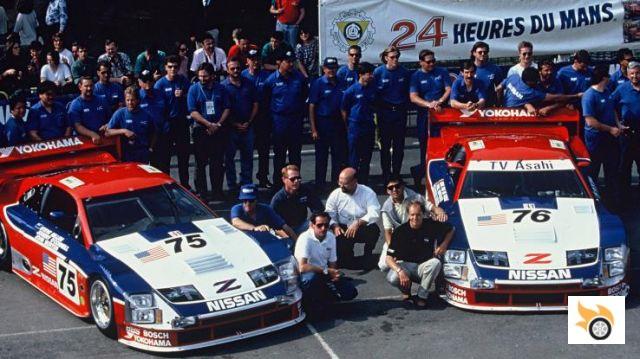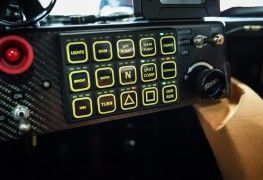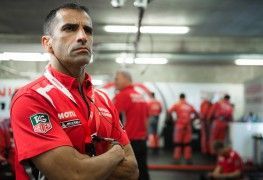With the GTP ZX-T comfortably winning GTP championships and shining brightly, Nissan decided to support more seriously a program for its newly released 300ZX Z32 from 1989 in the United States. The IMSA championship had organized a GT class (first called GTO, then GTS), where a liberal reading of the rules allowed for the creation of true racing beasts with tubular chassis and composite bodywork.
It was a car with a tubular chassis in chrome-molybdenum steel, equipped with an evolved VG30DETT, with double turbocharger, capable of delivering more than 800 horsepower to the rear wheels.
With those rules on the table, Nissan USA subcontracted Clayton Cunningham Racing to create a custom machine. So, from a tubular chrome-molybdenum steel chassis, a front-center-engine, rear-wheel-drive coupe was assembled. The heart of the beast was the VG30DETT. Originally it was planned to use the standard twin-turbo engine from the Z32, but it was too heavy, so the block was disassembled and replicated in aluminium alloy (the standard one was made of cast steel), creating a lighter and tremendously powerful engine.
The original gearbox was the standard five-ratio, but it would soon be replaced by a Hewland transaxle placed on the rear axle, to improve weight distribution. The bodywork had some similarity with the original 300ZX, but only the rear light clusters were kept from the street model. The rest was carbon fiber.
The engine, capable of delivering between 650 horsepower and 800 at the end of its racing career, was located under the windscreen to help reduce the polar moment of inertia. During the development of the car, the two turbochargers changed in size. It started with two large turbochargers, to benefit the power, but the lag was unbearable for the drivers, so it was decided to move to a smaller size and lower inertia, which allowed a more predictable response on the throttle.
He would go on to win IMSA championships in 1992 and 1994, with notable victories at the 12 Hours of Sebring and the 1994 24 Hours of Daytona.
Suspension was provided by double triangles on all four wheels, while the brakes were steel (no carbon ceramic brakes here). The maximum torque of the engine, 922 Nm, was another of the most powerful figures of a car that, in total, weighed 1,200 kilos with mandatory ballast to reach the minimum required by the championship.
Even though the car was very good, the first season the 300ZX could do little against the powerful Audi 80 IMSA GTO prototype, which used the engine and transmission of the old Group B quattro S1. The Japanese car's youthful problems were noticeable and it wasn't until 1990 that the machine really started to perform well.
Three victories would be taken by Steve Millen, the team's number one driver and hill climb expert (Rhys Millen, his nephew, is probably familiar to you from, among other things, Pikes Peak). Millen would go on to achieve even better results in 1991, with seven pole positions and five wins, with his teammate taking yet another victory. Unfortunately for Nissan, it wasn't enough to win the constructors' championship. 1992 would serve as revenge, with Millen taking another five wins, but not dropping out of the rest of the races, scoring good results that would earn him the title and also the constructors' championship for Nissan.
The 300ZX Z32 was by then the best racing car in its class for performance and reliability, and Millen started the 1993 season with four consecutive victories and looking towards what seemed to be a second consecutive title, until bad luck struck.
At Watkins Glen he suffered a bad accident when he overtook a lapped driver when he was leading the race. The lapped driver didn't see the 300Zx coming and moved unexpectedly and they collided leaving both cars crossed in some fast corners in that one before the finish line. The second 300ZX then came hurtling down the track and the accident suddenly happened, with no time to bring out the yellow flags, and a second, even bigger accident occurred, with Millen being thrown into the crash barriers in his car.
Rescue crews worked for an hour to free Millen from the wreckage his car had become after the second impact. He had a fractured skull, damaged muscles and nerves in his face, a broken jaw and a bunch of other broken bones.
It was the facial problems that took the longest to recover from. Millen couldn't close his eyelids, had trouble sleeping, couldn't focus properly... But little by little he fought his way back to full recovery until he was able to compete again in the 1994 season. Eager for revenge, Millen won the outright victory at the 24 Hours of Daytona, while the other 300ZX won the 12 Hours of Sebring.
With such a track record, Nissan decided to support the team financially for the 1994 24 Hours of Le Mans, a "rare" year when the prototypes did not have much official support.

The 300ZX Z32 IMSA GTS would go on to win its class, and even fight for overall victory, to finish fifth overall at Le Mans 1994.
The pair of 300ZX Z32s did well in qualifying, but it was in the race where they really shone. The #76 car dropped out with ignition problems, but the #75, Millen's car, kept the pace of the leading prototypes, the Dauer 962 that was leading Le Mans. It would not be without problems.
The Nissan first broke a gearbox bearing, and then suffered a timing problem, which cost him almost an hour of pit stops in total.
Finally the car was able to achieve a fifth place overall, and the victory in the IMSA GTS category (where, it must be said, they only had rivals to the RX-7 Mazda). Without the bearing and timing problems, the car could have fought for the overall victory, or at least that was the feeling that remained.
The rest of the American season ended with another IMSA GTS title and the feeling of absolute dominance that the championship organizers tried to control by banning twin-turbo engines. Nissan would then implement the eight-cylinder HRV used in its naturally aspirated prototypes.
But Millen suffered another serious accident, breaking his vertebrae. The recovery time was too long, and Nissan decided to cancel the 300ZX Z32 program in the championship, despite having a new car to use with the eight-cylinder.
In any case, Millen's achievement was now forever etched in the history of Nissan's first class win at Le Mans, and the epic return of a bruised Millen after the 1993 accident in which he almost lost his life.
The return of Alfa Romeo: from the 1900 to the Giulia




























